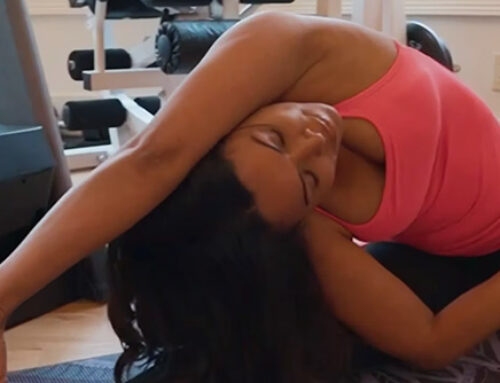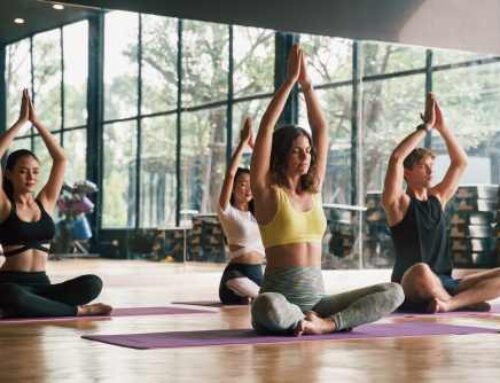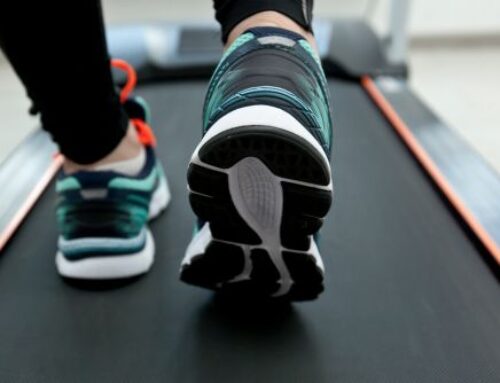Among their many benefits, exercise tools such as foam rollers are useful for releasing tension points, improving range of motion and supporting muscle recovery. Most serious athletes, bodybuilders and exercise enthusiasts own one or more of these handy, inexpensive tools, which continue to grow in popularity.
Like the foam roller, most of these tools are designed to be self-administered for the purpose of myofascial release, but you can use them with a partner if desired.
Your fascia is a band or sheath of connective tissue, primarily collagen, that provides support and protection for your muscles and internal organs. Fascia also can become tight due to inactivity, overuse or trauma caused by your job activities or workouts, or sometimes due to an accident, poor posture, repetitive stress injury or surgery.
When your fascia constricts, you may experience inflammation, which can result in a thickening of the connective tissue, as well as pain and irritation. By breaking down fibrous tissue, you boost your body’s blood circulation, which, in turn, promotes healing and helps relieve painful symptoms. Besides a foam roller, Prevention magazine1 suggests six other “must have” exercise tools to help you target problem areas and achieve relief in a matter of minutes.
Foot Massager: Bringing Relief to Your Hardworking Feet
Caring for your feet is an important consideration no matter what you do for a living, but most especially if your job or other activities involve a lot of walking or standing. After carrying you around all day, your feet deserve special attention.
Unfortunately, frequent neglect of your feet can result in serious aches and pains. For example, it’s vitally important you wear high-quality, supportive footwear. If you don’t, you may end up with plantar fasciitis, which occurs when the tendon running along your arch, from your toes to your heel, becomes inflamed.
Plantar fasciitis is extremely painful and may involve weeks or months of treatment and recovery. The pain is often at its worst when you take your first steps in the morning or after long periods of rest. Whether or not you have plantar fasciitis, using a foot massager to roll out aches and pains is an effective way to release tension in your feet and promote blood circulation. Golf, lacrosse or tennis balls can be used on your feet but they can easily slide out or roll away unless used on thick carpet.
Foot-specific rollers, which are generally slightly larger than a golf ball, can be used on any surface. Check out the video below for simple instructions on how to use a foot massage ball to address pain such as that caused by plantar fasciitis.
[embedyt] https://www.youtube.com/watch?v=Q6KiwawHBS0[/embedyt]
Lacrosse Ball: Dig Into Tight Muscles Alone or With a Partner
If you’ve ever had a massage therapist dig into one or more tension points on your back or shoulders, you may be happy to know you can use a lacrosse ball to achieve a similar effect. Due to its compact size, a lacrosse ball is perfect for addressing smaller muscles in your pecs and shoulders. You can also use a lacrosse ball to roll out your calves, shins and feet.
While it’s possible to work the lacrosse ball into an area by hand, you may be better served by placing the ball on the floor or using it against a wall. After positioning the affected area of your body over the ball, you can easily apply the desired intensity and pressure.
Another option is to find a partner and have them administer the lacrosse ball to your affected areas. Whatever you do, take things slowly to avoid causing further injury or irritation. You may need to ice tender areas afterward. Multiple sessions may be needed to address chronic tension points.
Medium Ball: A Good Alternative if a Lacrosse Ball Is Too Small
Medium balls are a great solution when you want to treat an area for which a foam roller is too big and a lacrosse ball is too small. If you spend a lot of time sitting, you can use a medium ball to loosen up tight glutes and hip flexors. You may also find it useful for addressing tight spots in your calves and hamstrings.
Massage Stick: Roll Out Cramps and Tight Muscles in Minutes
I personally use a massage stick on a regular basis, and highly recommend one called the Tiger Tail, which retails for less than $30. I keep it by my bedside to address the exercise-related leg cramps I occasionally experience during the night. Since the cramps I generally get attack my smaller muscles, making them difficult to treat with regular stretching, I use the Tiger Tail instead. After a few minutes of rolling over the cramping muscle, the pain typically disappears or at least has been significantly reduced.
The massage stick can also be applied to any other area of your body that is stiff and sore. By rolling it over an affected area, the motion increases blood and lymph flow to aching muscles. Getting more blood flow into the area promotes pain relief, improves circulation and relieves tension. Because massage sticks are easily manipulated, you can effectively control the amount and direction of the pressure.
You can use a massage stick before your workout to help prevent injuries and increase mobility. After a workout, use it to stretch muscles while they are still warm, making them less likely to shorten and become tight. The video below demonstrates how to use a massage stick to relax your quadriceps and hamstrings as part of your post-workout routine.
[embedyt] https://www.youtube.com/watch?v=yUPhUKymBFc[/embedyt]
Resistance Bands: An Inexpensive Way to Build Strength and Muscle
If you don’t have access to fancy gym equipment, resistance bands can help you increase strength and build muscular endurance as part of your home-based workout program. These stretchy bands are incredibly simple and yet extremely effective at working your muscles — helping you boost stamina, flexibility, range of motion and more.
Resistance bands are a quick means of changing up how you do familiar strength training moves such as arm curls. You can also intensify regular push ups by wrapping a resistance band around your upper body as you do them. Resistance bands are inexpensive, easy to store and perfect for exercising while you are traveling. No matter which type of bands you use, be sure to start with a light level of resistance and work your way up to higher levels of resistance over time.
Spinal Roller: Brings the Intensity of the Human Elbow to Self-Massage
These peanut-shaped rollers, which some have attempted to make at home by conjoining two tennis balls, can feel intense. It’s been suggested that spinal rollers — sometimes called a massage peanut or peanut ball — have a feel similar to the human elbow during therapeutic massage. For that reason, this tool should never be applied directly to your spinal column.
When used appropriately, however, especially on your back, shoulders and neck, a spinal roller can help reduce muscle tension and pain. It’s best to begin by gently rolling against the wall before you lie on a spinal roller. If desired, you can involve a partner in helping you target specific areas of tension.
Foam Roller: The Original Exercise Tool Still Adds Value to Your Workout
Now that you’re familiar with the six other tools, let’s also take a look at the foam roller, which has long been one of the most popular exercise tools. Despite the many other options, a foam roller can still add immense value to your workout. According to certified strength and conditioning specialist Jeff Barnett, as reported by Breaking Muscle:2
“Foam rolling works by returning your muscles and soft tissue to their native form. Exercise, injury and the rigors of life can cause knots that restrict mobility and performance. By smashing those knots and allowing soft tissue to operate correctly again, foam rolling increases range of motion and improves workout performance.”
A 2013 study3 published in The Journal of Strength & Conditioning Research supports the use of a foam roller for myofascial release, indicating it can dramatically increase your range of motion without negative effects on strength. Eleven well-trained men were tested for strength, after which they used a foam roller for two minutes on their quadriceps.
Follow-up testing indicated use of the foam roller did not affect strength, but did increase range of motion. In fact, the average improvement in knee flexion, for example, was noted as 8 to 10 degrees, which is significant. Said Joshua Wortman, bodybuilding and strength training coach, of Breaking Muscle:4
“This study is one of the first peer-reviewed studies on self-myofascial release (SMR), and it proved what many bodybuilders and powerlifters have been preaching for some time — foam rolling works. Not only can it help improve joint range of motion and overall muscle recovery, it does so without sacrificing muscle performance and strength.
Perhaps the biggest benefits of SMR are that it can be done entirely by the individual and is very efficient in that it can take as little as 30 to 60 seconds to target the desired muscle group.”
[embedyt] https://www.youtube.com/watch?v=YbkOcHGFXWY[/embedyt]
5 Mistakes to Avoid When Using a Foam Roller
As with any other exercise protocol, form and technique are extremely important considerations when you are using a foam roller. While a foam roller can provide relief to a tight muscle or sore spot, you can use it more broadly to achieve even greater benefit. The video above, featuring Mercola.com personal trainer Jill Rodriguez, showcases proper techniques for using a foam roller during exercise.
She suggests using foam rolling before exercise to improve circulation and range of motion, and afterward to promote muscle recovery and relaxation. To avoid injury or further irritation, be sure to avoid the following common mistakes related to the use of foam rollers:5
1. Rolling Directly Where the Pain Is
While your first inclination may be to apply foam rolling directly to a painful area, it’s important to approach your body as whole unit instead of a series of smaller parts. The ache you feel in one area may be the result of issues going on somewhere else in your body. In addition, rolling a painful, inflamed area has the potential to increase inflammation and inhibit healing. It’s better to take a less-direct approach says neuromuscular specialist and manual therapist Sue Hitzmann, who told Huffington Post:6
“Areas of pain are the victims that result from tension imbalances in other areas of the body. If you find a spot that’s sensitive, it’s a cue to ease away from that area by a few inches. Take time and work a more localized region around areas that feel sore before using larger, sweeping motions.”
2. Rolling Too Fast
Your movements on the foam roller should be slow and concentrated — avoid rolling too quickly. If you roll too fast, your muscles won’t have time to adapt to and manage the compression, which means you will most likely not be successful in eliminating adhesions. Also, rolling slowly gives your brain sufficient time to tell your muscles to relax.
3. Spending Too Much Time on Knots
While it’s perfectly OK to work on your knots with a foam roller, you could cause damage to your nerves or tissue if you dwell on one spot for too long of a time. This is particularly true if you bear down with your entire weight on the knot.
Ideally, spend about 20 seconds on each tender spot and take care with the amount of pressure you apply. When using a foam roller, apply just enough pressure to release tension, and focus on making small movements back and forth. While a mild amount of discomfort is expected with foam rolling, you should back off if you are feeling intense pain in a single area.
4. Using Bad Posture
Posture is an important consideration in all forms of exercise. Using a foam roller properly requires you to hold your body in various positions, and the form you use matters. If you slump or slouch during foam rolling, you might exacerbate existing postural issues, create further irritation or cause serious injury.
If you are not sure you are using the correct form, it may be worth your time to seek out the assistance of a personal trainer who has experience with foam rollers. Another option for learning proper technique is to participate in a foam-rolling class at your local health club or recreation center.
5. Using a Foam Roller on Your Low Back
Whatever you do, do NOT use a foam roller on your lower back! While it’s OK to work your upper back with a foam roller — because your shoulder blades and muscles offer adequate protection for your spine — working your lower back would be totally counterproductive and put you at risk for injury.
“The thing that makes me cringe is when people foam roll their lower back,” states National Academy of Sports Medicine-certified personal trainer Monica Vazquez.7 “You should never, ever do that. Once you hit the end of the rib cage, stop.” To release your lower back, try rolling the muscles connected to it, such as your piriformis (located within your glutes), hip flexors and rectus femoris (a main muscle in your quads).
Choose One of These Tools and Get Started Today
I cannot stress enough the importance of stretching and mobility to your overall health. While addressing limitations related to your health and fitness is not always “fun,” it is vital to ensure you will continue to be an independent, high-functioning individual for many years to come.
While it may be hard to imagine it now, especially if you are young, possessing physical strength and agility, as well as full range of motion in your joints, will ultimately influence your ability to live a full and active life, as well as properly care for yourself in old age. If all this talk about exercise tools is new to you, start small by investing in and getting familiar with just one of the tools. If you’ve been exercising regularly, now may be the time to take your workout to the next level by adding one or more new tools to your routine.
Because your muscles adapt quickly to any workout routine, it is important to keep adding variety and new levels of challenge as you go along. None of the tools are complicated or particularly expensive. In less than 10 minutes a day, you can begin to increase your flexibility, while taking the edge off any irritation and pain you may be experiencing. Even a small investment toward optimal health is sure to pay big dividends later. Get started today!
Sources and References





Leave A Comment